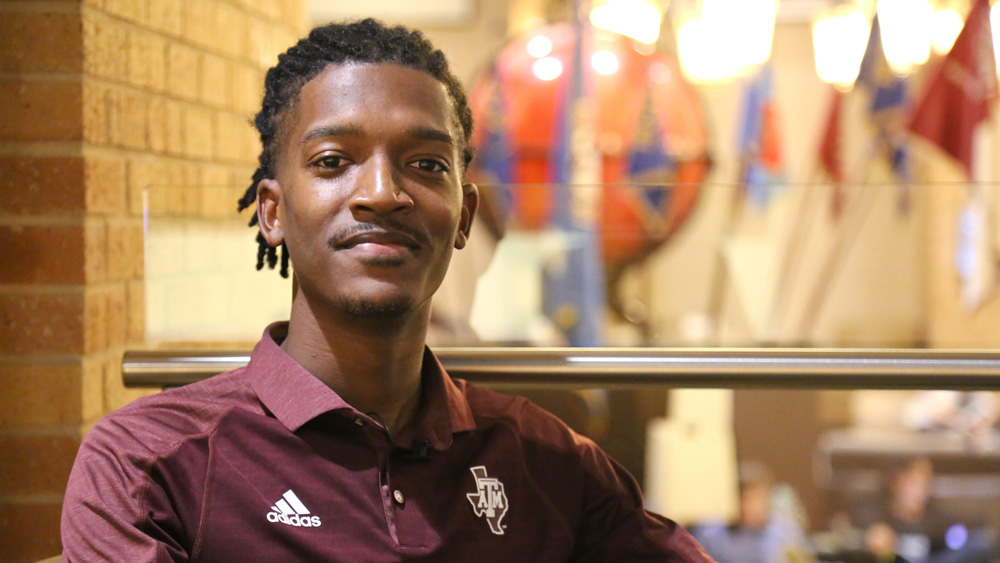
Stories of hard work are a hallmark of collegiate success, but perhaps few students have represented this better than Roger Simon, a graduate student in the Department of Aerospace Engineering at Texas A&M University. Simon was selected as a participant of the National Science Foundation (NSF) Louis Stokes Alliances for Minority Participation (LSAMP) Bridge to the Doctorate (BTD) program, allowing him to pursue the first two years of his graduate program fully supported.
“Getting a chance to do something that I am really passionate about and not having to worry about finances is a great thing,” said Simon. “I like helping people and I figure that being in this program gives me a chance to give back and encourage undergraduate students to work hard and tell them that anything is possible.”
The LSAMP program’s objective is to increase the quality and quantity of underrepresented minority students successfully completing science, technology, engineering and mathematics (STEM) baccalaureate degree programs. As a part of the LSAMP initiative, the NSF BTD program sponsors a cohort of 12 selected students for the first two years of their graduate studies. The program grants students an annual stipend for educational expenses and provides them with networking opportunities.
Simon’s area of research, under the guidance of his graduate advisor, Dr. Edward White, associate department head and professor in the department, is experimental aerodynamics and the dynamics of water droplets that are exposed to air. Simon aims to understand why water droplets behave the way that they do
“We run different wind tunnel tests with a solid hemisphere in the wind tunnel and we are studying different things like vortex shedding frequency and understanding the sloshing frequency that happens whenever air is blown over a water droplet,” said Simon. “We are looking to apply it to different things, like aircraft icing on a wing or heat exchangers.”
Simon’s passion for aerospace has been a part of his life since childhood. Ever since he received his first radio-controlled helicopter at the age of eight, he knew he wanted to be an engineer. Simon was fascinated by flight and wanted to know the intricacies and dynamics of the model toy. After going on his first airplane flight at age 13, Simon knew he wanted to pursue a degree in aerospace engineering.
“I fell in love with the whole idea of just taking off from the ground and going off into the unknown,” said Simon. “The reason I chose to come to A&M was
Once at Texas A&M, Simon got an opportunity to research abroad as an undergraduate student and participant of the Engineering Learning Community Introduction to Research program. The program offers underrepresented freshmen engineering students a high-impact learning and research opportunity to gain research combined with a global experience. Simon was also a Regent’s Scholar and participated in the endowed Engineering Success Program seminar class. He was also a member of the National Academic Council for Minorities in Engineering and a member of the Zachry Leadership Program (ZLP), a program that empowers undergraduate students with soft skills to become well-rounded, future leaders in engineering. For those that have known Simon since his undergraduate career, his acceptance into the BTD program comes as no surprise.
“I’ve known him through thick and thin since he was a freshman in the success engineering seminar,” said Dr. Sonia Garcia, senior director of the Access and Inclusion program in the Engineering Academic and Student Affairs Office. “Not only has he demonstrated how to be a reliable, brilliant and involved student, but he’s also an amazing, reliable and genuinely good young man.”
According to Garcia, Simon’s achievements as an undergraduate student have served to inspire other students, both through his mentorship and his actions.
“For those that are interested in (pursuing) their education but thought that they are not at that point, or aren’t good enough, or don’t have what it takes, Roger can be a game changer,” said Garcia. “I know that students leave with a good impression when they see someone that looks like them, or talks like them, or lives in the same neighborhood as them; they feel more comfortable and say ‘if you did this, then I can do this.’”
Simon plans on continuing research in his main interests of study throughout graduate school. He said that his aspirations include continuing to be a role model to all students, including underrepresented minorities, and someday becoming a professor to teach students of his own. He said that he is humbled by his accomplishments and is thankful for all of the people that have helped him get to where he is now.
“If you truly believe in yourself then you should be willing to work extremely hard and be willing to do things that are out of the norm to get there,” said Simon. “Getting the chance to receive my bachelor’s degree in May and have my parents here to see it was a great experience and I just want to do it again when I get my master’s degree.”